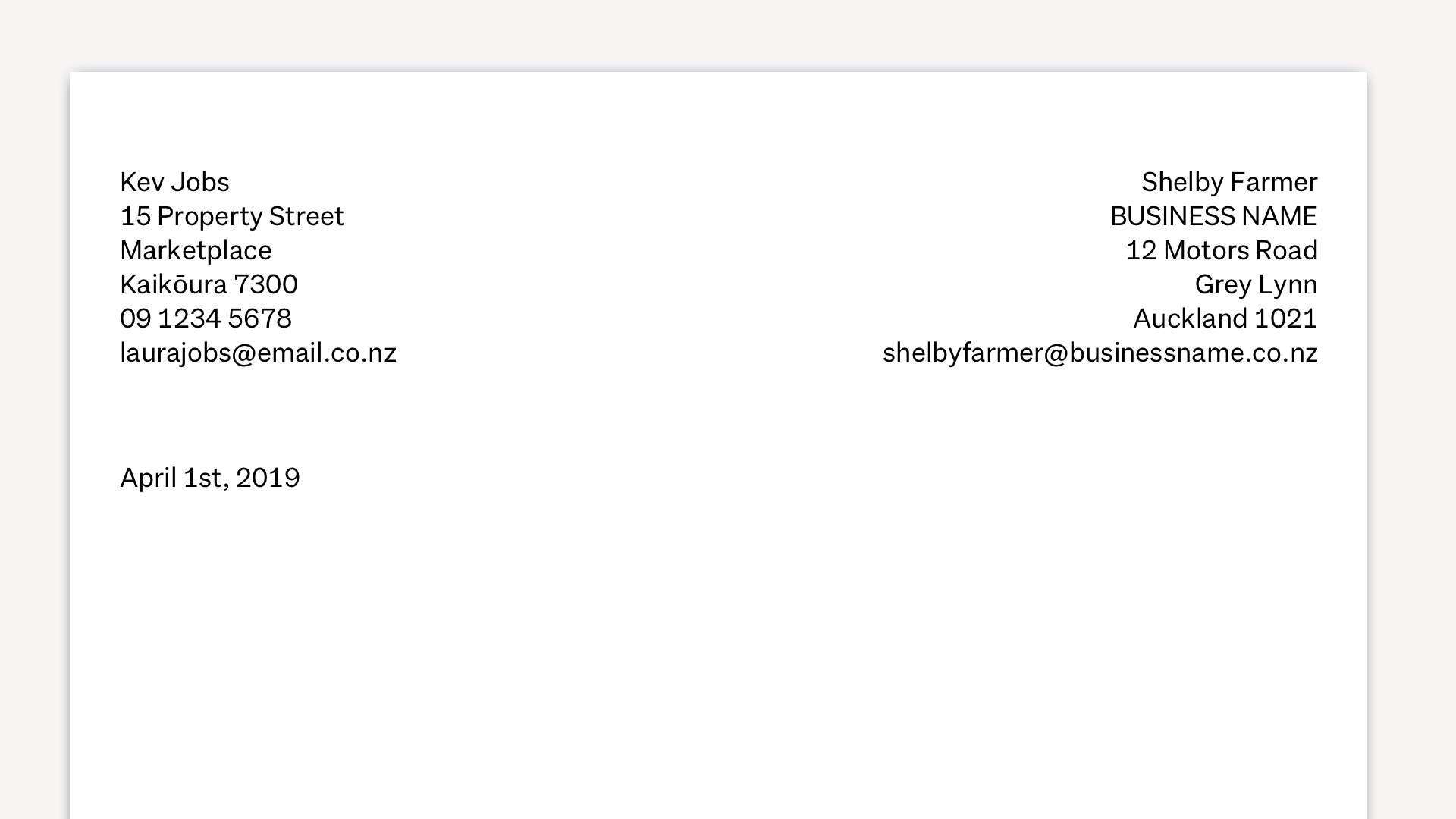Careers advice
What to include in a NZ cover letter (with templates)
Here’s everything your cover letter needs to contain.
Last updated: 31 March 2023
What you’ll learn:
- How long should your cover letter be?
- What to include in your cover letter
- Do you need to write a different cover letter for each job application?
Yes, you should write a cover letter for every job application you make in New Zealand. Whether it’s your first job helping out at your local dairy, or you’re applying for a CEO role, this document needs to be submitted.
But what exactly do you need to include in your cover letter? Well, spoiler alert, it shouldn’t just be your CV written out in full sentences.
In this article, we’ll break down the core essentials that you need to include in your cover letter, and also provide some free downloadable cover letter templates to make things even easier for you. Aren’t we nice?
How long should your cover letter be?
One of the key challenges of writing a cover letter is cramming all the necessary information in, so before we tell you what you need to include, you need to know how much space you have..
Luckily’ it’s a pretty easy one to remember: a cover letter in New Zealand should fit onto a single A4 page.
However, remember, you need to lay your cover letter out like a formal letter. If you don’t know what we mean, check out our free downloadable cover letter templates, but in practice this means that you only have two or three paragraphs to make your key points, because the formatting takes up lots of space.
What to include in your cover letter (with examples)
1. Your name and contact details
At the top left-hand side of the page should be your name and contact details. These need to be presented in a block style, as they would appear on a formal letter. The contact details you need to provide are:
- Your current home address.
- Your email address.
- Your best contact number.
Here’s an example of what it should look like:
Nina Manmain
123 Brooklyn Road
Wellington
02012345678
n.manmain@email.com
This is what the top of your cover letter should look like.
2. The date
As with any formal letter, you need to include the date.. This should also go at the top, typically in the middle or in the top right corner.
3. The name, address and business name of the person you’re writing to
Make every possible effort to find a name to address your cover letter to. It provides a really important personal touch to your job application, and instantly grabs the attention of the reader.
There are a few places you can look to find who you should be addressing your cover letter to:
- The job advert: in an ideal world, the company will have included the name of the hiring manager, or a contact person, in their listing on Trade Me Jobs. This will normally be at the end of the listing, and will look something like “Contact NAME with your CV and cover letter.”.
- The company’s website: hopefully you’ll know what department you’re applying to, so you might be able to check out the staff page on the company’s website to look up the manager’s name.
- The company’s social media: similar to the above, this can be another avenue for scoping out the best person to address your cover letter to.
You also need to include the name of the business and its physical address on your cover letter. This should be written in a block format, and should look something like this:
MANAGER NAME
COMPANY NAME
COMPANY ADDRESS LINE 1
COMPANY ADDRESS LINE 2
4. Your cover letter salutation
A cover letter salutation is just a fancy way of your greeting. Typically, this will be something like Dear HIRING MANAGER NAME.
You have a judgement call to make here. If you think the company is an informal one, you might choose to go for the most personal salutation, and use the hiring manager’s first name, i.e. Dear Sarah.
If, however, you’re applying for a role in a formal company, or a formal sector like law or banking, you’ll probably want to go with something along the lines of Dear Rawiri Smith. Of course, if you know the hiring manager has a different title, Dr, for example, then you’ll want to use that.
In the circumstances where you really can’t find a real person to address your cover letter to, then the standard fallback is Dear Sir/Madam. It’s not ideal, but if there isn't a name, this is your best bet.
Your cover letter saluation is like a written handshake.
5. The role you’re applying for, and how you heard about it
It might sound pointless, but you do need to directly name the role you’re applying for in the first paragraph of your cover letter. You need to remember that the business, and maybe even the hiring manager you’re writing to, has multiple vacancies that they’re recruiting for, so make it clear which one you’re applying to.
You also need to mention where you saw the job listing. This is a useful piece of info for the company to gather, as it shows them where their pipeline of quality candidates is coming from.
Finally for this paragraph, you should express some enthusiasm about the job, and give them an indication of why it appeals to you.
For example, your opening paragraph could like this:
“I’m writing to apply for the kayak guide role I saw advertised on Trade Me Jobs. As an experienced kayaker, with several qualifications under my belt, and with previous experience working in tourism, this role struck me as one where I could contribute to your team and also learn vital skills.”
6. Why you’re suitable for the role
This section, and the one after, are the real bread and butter of your cover letter.
For this first one, you need to provide a summary of the skills and experience you have that make you qualified for the role. Crucially, this should not be a complete rewrite of your CV. You need to specifically cherry pick skills from your previous employment (or education) that fit with what the company is looking for.
The best thing to do is look for key skills and competencies listed in the job description, and provide tangible examples of how you meet the mark, using facts and figures. For example, rather than just saying you’ve ‘increased sales’ in your previous role, tell them you ‘increased sales by X%’. Giving a precise figure like this catches the eye and sticks in the mind, and, as long as you’re not exaggerating or lying, can be a real asset in a job interview.
This section could look something like this:
My BCom in Marketing gave me a solid grounding in crucial marketing skills, ranging from statistics to e-Commerce. I particularly enjoyed tasks which involved using data to develop and run successful email and paid advertising campaigns.
I added to this experience in summer 2022 as an intern at The Business Company, where I worked alongside full-time staff to grow their email engagement by 4% in three months. I’m now looking to build on what I’ve learnt in a fast-moving and customer-centric organisation like yours, while continuing to develop myself professionally.
The heart of your cover letter should emphasise what you bring to the table, and why you want to work for them.
7. Why you want to work for them
While the main point of writing a cover letter is to sell yourself, you also need to convince the reader that you really do want to work for them. In other words, they want to see that this isn’t just another cover letter you’ve written because you really need a job, and that instead you’ll be an engaged and proactive team member.
Crucially, this isn’t an exercise in bootlicking. Telling the hiring manager that you’ve always dreamed of working at their two-month old startup isn’t going to convince anyone, and really doesn’t mean a whole lot. Instead, you need to give specific reasons why their organisation and this role speak to you.
Solid examples of what to include in this section of your cover letter include:
- Company values and culture: company values have really come to the fore in recent years, so describing how well you feel you’d fit into these is important. Many companies post their values on their website, so read these carefully, and pick a couple that really speak to you.
- The product or service: if you really do have a passion for what the organisation does, sells or promotes, talk about it. Where possible, try and weave a narrative that explains why you’re into it, rather than just stating that you are.
- Their past achievements: if the organisation is known for having done something that you find impressive, this is worth mentioning. This helps prove to the reader that you have indeed heard about them before you saw their listing on Trade Me Jobs.
For example:
“Having worked in data analysis for years, the opportunity to use my skills for a cause that I really believe in is something I’ve been seeking for some time. COMPANY NAME’S reputation for using data to show businesses how they can cut down on their fossil fuel emissions is not only innovative and impressive, but is something that would allow me to continue to develop my skills within an organisation that shares my passion for environmental sustainability.”
8. Your sign off
Keep the end of your cover letter simple. All you need to do is convey again how keen you are for the role, thank the reader for taking the time to assess your application and provide a friendly goodbye.
For example:
“The idea of working for a news organisation that puts the stories of its readers at the heart of its reporting is something that really motivates me.. I believe my skills and experience, as well as my passion for your mission, would allow me to do this effectively, and I’d love to become a part of your team. Thank you for taking the time to read my application, and I look forward to hearing from you.
Yours sincerely,
YOUR NAME’.
Do you need to write a different cover letter for each job application?
Yes, you absolutely do need to write a different cover letter for each job application you make. As we hope this article has emphasised, you need to tailor your cover letter to both describe how you fit the role, and how the role fits you.
If a hiring manager or recruiter gets even the slightest sniff of a mass-produced cover letter that they think you’ve sent to a whole bunch of other organisations, chances are your application is dead in the water and they’ll go with someone else.
Author




